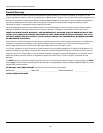
3
Pump Installation
Installation of this
unit may take
several hours. Before disabling your
main pump, have ready an appropriate
means of evacuating the sump.
1. Turn power to main pump off.
2. Pump must be installed using 1
1
/
4
”
or 1
1
/
2
” rigid PVC piping.
Pump Installation
The ESP45 can be installed as a back up
system with a separate dedicated
discharge line (Method 1), or tied into
an existing sump pump line (Method 2).
Unplug the existing
AC pump. Failure to
follow this warning could result in fatal
electrical shock.
1. Verify that the existing AC pump is
in good working order. If the AC
pump is questionable, it is typically
recommended that the unit be
replaced with a 1/3 or 1/2 HP pump.
2. Remove any silt or accumulated
debris from the sump pit and
surrounding area.
Method 1 (Preferred)
1. Locate the ESP45 on a solid, level
surface in the sump pit. Do not
place the pump on a loose or sandy
surface. Small stones or sand may
damage the pump resulting in
potential pump failure.
2. This pump has a 1
1
/
2
” NPT discharge.
If a 1
1
/
4
” discharge pipe is desired,
an adapter (not included) will be
necessary. Smaller diameter piping
will reduce pump flow, rate and
performance.
3. Cut a 4’ section of 1
1
/
4
" or 1
1
/
2
"
diameter rigid PVC pipe. Cement
1
1
/
4
" pipe to a threaded fitting.
Cement 1
1
/
4
" pipe into pipe
coupling. Attach 1
1
/
4
" pipe section
to the ESP45 discharge adapter.
4. Screw on to pump discharge.
Be careful not to
strip or cross thread
plastic fittings or check valves. Flex hose
is not recommended. Rigid PVC or metal
pipe is required for a permanent
installation.
ESP45
www.waynepumps.com
Figure 2 - Method 1
Floor
Joist
Ridgid
PVC
Pipe
1
1
/
4
” or
1
1
/
2
”
PVC Pipe
ESP45
Pump
Existing Pump
Check Valve
(See Step 6)
Slope
Pipe
Down
PS/BC
5. Place the pump with the 4’ section of
PVC pipe on a solid, level surface in
the sump pit on an elevated surface.
6. Attach a rubber check valve (sold
separately) to the top of the
discharge pipe. This will allow the
pump or check valve to be removed
easily for servicing.
7. Check valve is required for effective
operation of system.
NOTE: Check valves can be placed
directly in the pump discharge if
desired. However, for ease of
disassembly, it is recommended that
check valves be placed above the sump
as shown in Figure 2.
The remainder of the discharge pipe
installation will vary depending on
individual circumstances. Using sound
plumbing practices, route the
discharge pipe to an exterior wall by
the shortest path. Keep turns to a
minimum because they reduce flow
output of the pump. The pipe that
exits the building structure should be
sloped downward so that water will
not freeze in the pipe.
When installing the separate discharge
pipe, drill through the outside wall with
appropriate drilling equipment. Seal the
hole to prevent water from entering.
Method 2
If a separate, dedicated discharge is
not possible as in Method 1, the ESP45
pump can be tied in to the AC-
operated pump’s discharge pipe by
installing a “Y” connector. Two check
valves will be required.
1. Locate the ESP45 on a solid, level
surface in the sump pit. Do not
place the pump on a loose or sandy
surface. Small stones or sand may
damage the pump resulting in
potential pump failure.
2. This pump has a 1
1
/
2
” NPT discharge.
If a 1
1
/
4
” discharge pipe is desired,
an adapter (not included) will be
necessary. Smaller diameter piping
will reduce pump flow, rate and
performance.
Batteries
Battery
Box










